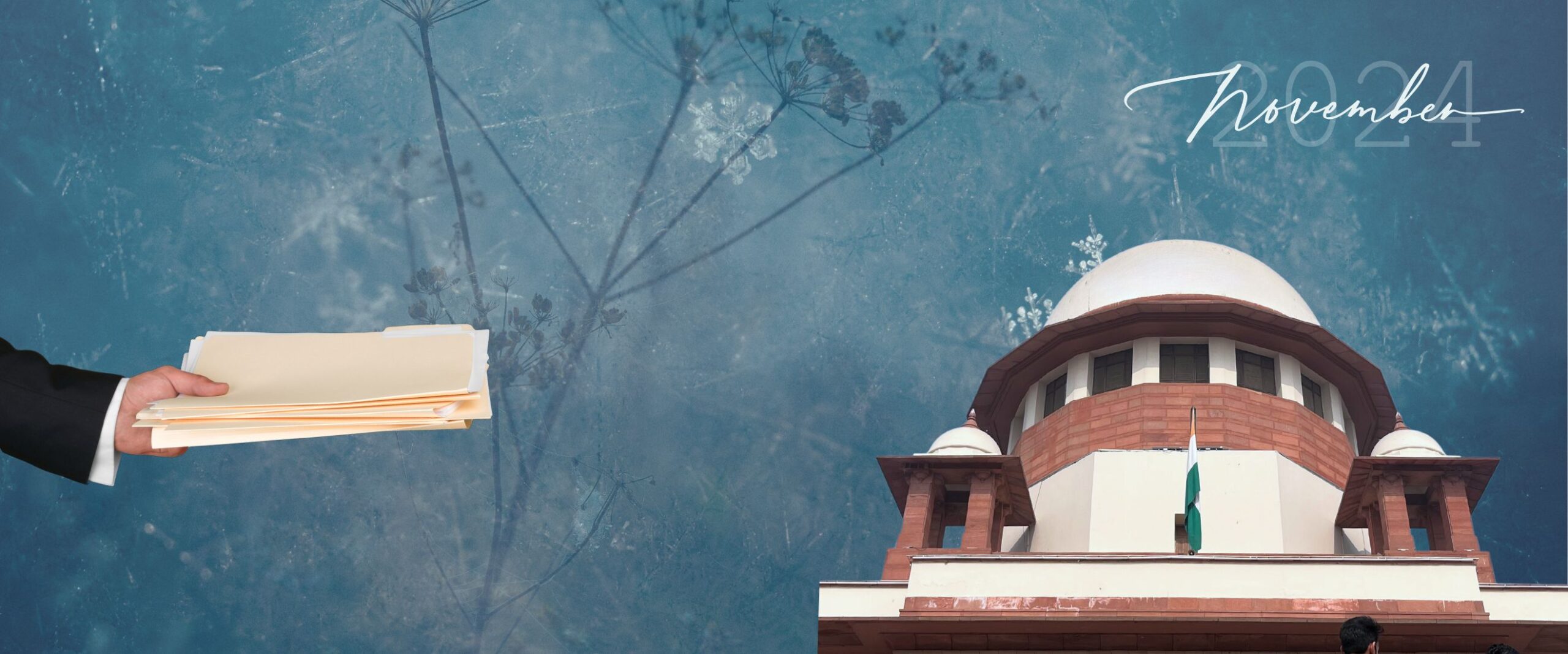Court Data
November 2024: Supreme Court clears 1008 more cases than October
The new Chief Justice’s decision to halt regular hearings resulted in a 16 percent increase in disposal rate in November 2024

In November this year, the Court disposed of more cases than were instituted for the first time since July.
Institution refers to the number of cases filed at the Court in a given period and disposal refers to the number of cases the Court clears either by delivering the final judgement or by dismissing them.
5339 cases instituted, 5571 disposed
Figure 1 shows a month-wise breakdown of the number of cases instituted in and disposed of by the Supreme Court from January to November 2024.
Note: The November 2024 data was collected from the National Judicial Data Grid (NJDG) on 9 December 2024 at 10:50 am.
As seen in Figure 1, in November, the Court received 5339 cases (161 cases more than in October) and disposed of 5571 cases (1008 cases more than in October).
The Court worked for 19 days in November, clearing an average of 293 cases per day.
This increase is worth remarking on for two reasons. First, there was a change in administration at the beginning of the month with Chief Justice D.Y. Chandrachud retiring on 10 November 2024 and CJI Sanjiv Khanna assuming office on 11 November.
Second, after CJI Chandrachud’s retirement, the Court was two judges short of its full sanctioned strength of 34 judges. Yet, the disposal numbers did not decrease. Let’s take the instance of August for comparison. Despite working at full sanctioned strength that month, the Court disposed of 1100 cases less than in July.
The likely reason for the increase in disposal is CJI Khanna’s decision that the Court would not hear regular matters (which have proceeded to the hearing stage) “until further notice”. Some Advocates on Record suggested that the move was prompted by CJI Khanna’s desire to reduce pendency. The Court often doesn’t grant leave to appeal in ‘after-notice’ matters (where notice is issued but the hearing hasn’t commenced). The more of these matters it hears, the more likely it is to make progress with clearing its docket. On 10 December, the Chief announced that regular matters would be listed again from January 2025.
Highest disposals in the last four months
January: The Court began the year with a packed schedule after its winter break. It registered 4964 new cases and disposed of 5453. A seven-judge Constitution Bench was active for seven of the 20 working days.
February: A total of 4821 cases were instituted. Despite operating at full strength for 21 days, the Court disposed of 5409 cases—44 fewer than in January. Constitution Benches heard three cases over seven days.
March: For the first time in 2024, institution exceeded disposal with 4656 new cases and 3926 cases cleared. The week-long Holi break meant that there were only 15 working days. Nine judges heard Constitution Bench matters for five days.
April: Activity increased as 5613 cases were filed and 4813 disposed of. Two Constitution Bench hearings kept nine judges occupied for 10 out of 19 working days.
May: Ahead of its summer vacation, the Court received 5418 cases and cleared 3610 during its 13 working days.
June: Expectedly, the Court’s vacation led to a sharp decline in activity, with only 2643 cases instituted. Vacation Benches managed to clear 613 matters.
July: Resuming after the break, the Court achieved its highest monthly disposals for the year, disposing of 6198 cases. The month also saw the year’s highest number of new cases at 5949. Notably, the month marked the first reduction in the case backlog since February, with pendency reducing by over 900 cases.
August: With 18 working days, the Court received 5530 cases and disposed of 5063 despite working at full sanctioned strength.
September: The last month in the Court’s third quarter saw 5672 new cases and 5142 disposals. The Court worked with 33 judges for 20 days.
October: 5178 new cases were filed at the top court and 4563 cases were disposed of—bringing the clearance rate to 88.12 percent. This could be attributed to the fact that the Court worked for only 13 days during the month owing to the Dussehra and Diwali breaks.
Note 1: In our monthly updates on case institution and disposal at the Supreme Court, we also examine inconsistencies in data between two platforms: the National Judicial Data Grid (NJDG) and the Justice Clock. The Justice Clock, hosted on the Supreme Court’s website, provides real-time updates, while the NJDG, managed by the Department of Justice, collects data from the Supreme Court, High Courts, and subordinate courts.
We’ve observed occasional delays in data syncing between the two platforms. For example, the numbers were consistent for February, March, August, and September. However, discrepancies arose in January, April, May, June and July. In October, both platforms largely aligned, with minor differences—three cases in disposals and four in institutions. In November 2024 too, the numbers more or less matched up. The Justice Clock displayed an institution of 5339 cases (same as on the NJDG) and a disposal of 5577 cases (six cases more than the NJDG).
Note 2: In our monthly tracking of institutions and disposal of cases, we also track the monthly trends for the last five years (2020-2024). However, we’re unable to carry out this part of the analysis for the months of November and December since the historical data for these months is not available in the Supreme Court’s annual reports for past years. [The report is typically published in October each year].




